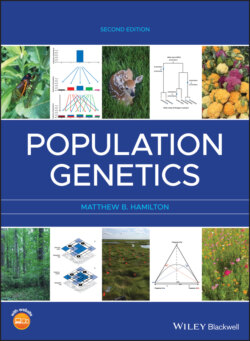Читать книгу Population Genetics - Matthew B. Hamilton - Страница 48
Mixing of diverged populations
ОглавлениеThe mixing of two genetically diverged populations, often termed admixture, can produce substantial levels of gametic disequilibrium. This is caused by different allele frequencies in the two source populations that result in different gamete frequencies at gametic equilibrium. Recombination acts to produce independent segregation but it does so only based on the allele frequencies within a group of mating individuals. Table 2.13 gives an example of gametic disequilibrium produced when two populations with diverged allele frequencies are mixed equally to form a third population. In the example, the allele frequency divergence is large, and admixture produces a new population where gametic disequilibrium is 64% of its maximum value. In general, gametic disequilibrium due to the admixture of two diverged populations increases as allele frequencies become more diverged between the source populations, and the initial composition of the mixture population approaches equal proportions of the source populations.
